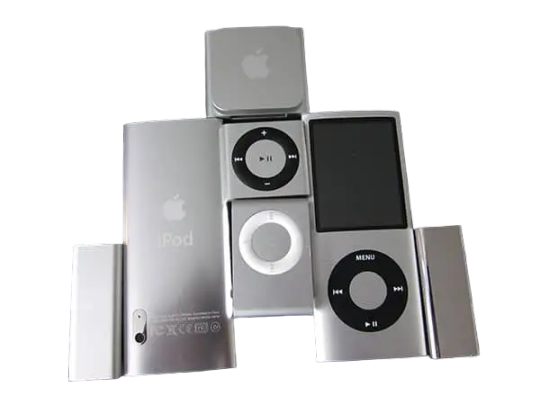Welcome to 3rdWave — where the future lives, breathes, and wears its heart on its sleeve. --- www.3rd-wave.ca
Don't wanna be here? Send us removal request.
Text

FDA approves breakthrough eye drops that fix near vision without glasses https://newatlas.com/aging/age-related-near-sighted-drops-vizz/
7 notes
·
View notes
Text






Assortment of mixed generations of the apple ipod shuffles + nanos in clusters of like-colors.
32K notes
·
View notes
Photo

Two Performers Share a Stream of Electricity While Standing on Tesla Coils in Shandong, China
18 notes
·
View notes
Text
Empirical Learning for Dynamical Decoupling On Quantum CPUs

Empirically Optimised Dynamical Decoupling Improves Quantum Computation.
Despite its potential, quantum computing is hindered by the fragility of quantum states, which are susceptible to ambient noise mistakes. Numerous error suppression and mitigation solutions are being studied to eliminate these defects and increase quantum calculation reliability. Dynamical Decoupling reduces quantum computation defects most efficiently and cheaply.
Suppressing Errors on Noisy Hardware
Despite advances in DD design, pulse sequences that successfully decouple computational qubits on noisy quantum devices remain a challenge. Quantum processor noise is complicated and dynamic, therefore theoretically-derived DD sequences often fail in practice. This requires a more flexible and hardware-sensitive DD implementation.
Empirical Optimisation: A New DD Method
Recent discoveries have introduced a powerful paradigm: empirical optimisation of DD sequences. Learning algorithms or combinatorial optimisation are used to empirically find device-tailored DD sequences. Instead than using theoretical models, this method discovers optimal approaches using quantum hardware experiments.
Empirical learning is used to optimise DD (GADD), inspired by genetic algorithms. In particular, this strategy has optimised DD procedures for IBM's superconducting qubit-based quantum processors. GADD simulates natural selection by enhancing Dynamical Decoupling (DD) sequences based on how well they suppress quantum device errors.
Outstanding Performance and Generalisability
Empirical optimisation yielded excellent results. We found that empirically taught DD approaches suppress errors better than canonical sequences in all experimental settings. These experimentally optimised sequences reduce superconducting qubit noise better than theoretically derived DD sequences and traditional decoupling sequences like CPMG, XY4, and UR6.
The harder the computer problem, the better these experimentally learnt solutions work. Error suppression improves with problem size and circuit complexity. This discovery is significant as quantum algorithms get more complex and require more qubits and deeper circuits.
Advantages of this empirical learning approach include stability and generalisability.
The approaches identified provide long-term performance without retraining. Maintaining peak performance reduces operational expenditures.
The optimisation approach is scalable and successful for increasingly complex quantum systems since these empirically taught methods can generalise to bigger circuits when trained on modest sub-circuit architectures. The methodology also finds time-constant ways as circuit width and depth increase.
Practical Uses and Benchmarking
Empirically optimised Dynamical Decoupling (DD) performs well on many quantum techniques and scales:
Mirror randomised benchmarking on 100 qubits was examined.
This prepared 50 qubits for GHZ states.
It improved the 27-qubit Bernstein-Vazirani algorithm.
This method can increase near-term quantum gadget performance, as shown by these investigations. IBM has led this study and may have combined these results with Qiskit. IBM prioritises quantum computing and software.
Bigger context and future implications
Dynamic decoupling is a simple error suppression method. Combining it with empirical learning makes quantum computation more resilient. This study aligns with quantum error mitigation efforts including adaptive Dynamical Decoupling (DD) frameworks and context-aware compilation to reduce crosstalk and correlated noise. It emphasises the importance of a comprehensive strategy that uses hardware and algorithm design to enable reliable and high-quality near-term quantum algorithm execution.
4 notes
·
View notes
Text
What Makes AC/DC Adapters Essential for Modern Electronics?

AC/DC adapters are everywhere—from your home office to industrial settings—powering laptops, routers, audio equipment, and countless electronic devices. But what makes these adapters so vital in the electronics landscape? This blog explores everything you need to know about AC/DC adapters, including how they work, the different types, benefits, key features, safety tips, and trending applications, all while integrating top search keywords like connectors, controllers, sensors, cables, switches, and more. Let’s dive into why AC/DC adapters remain an integral component in our plugged-in world.
How Do AC/DC Adapters Work?
AC/DC adapters convert alternating current (AC) from wall outlets into direct current (DC) suitable for electronic devices. This conversion is crucial because most electronic components—such as microcontrollers, LEDs, laptops, and sensors—require a stable DC voltage for operation.
The Role of Power Conversion
AC power is available in most households and workplaces, typically at 110V or 220V.
DC power is required for low-voltage devices like routers, thermal pads, capacitors, and microprocessors.
An adapter bridges this gap, delivering safe, usable power.
Internal Components of an Adapter
Rectifiers transform AC into DC.
Filters smooth out voltage fluctuations.
Regulators maintain consistent voltage and prevent spikes.
Output connectors ensure compatibility with devices.
What Types of AC/DC Adapters Are Available?
The range of AC/DC adapters is vast, offering solutions for almost every application. Choosing the right type ensures safe and efficient operation of your electronics.
Plug-in Adapters
Ideal for household devices like routers, LED strips, and laptops.
Compact, portable, and easy to use.
Desktop Adapters
Higher power ratings for monitors, printers, or controllers.
Usually come with a detachable power cable.
Universal AC/DC Adapters
Adjustable voltage and interchangeable connectors.
Great for travel or when replacing lost adapters.
Industrial AC/DC Power Supplies
Designed for machinery, sensors, contactors, and safety devices.
Rugged, reliable, and suitable for demanding environments.
Why Are AC/DC Adapters So Important?
Without reliable adapters, most electronics would be unusable or unsafe. The impact of these adapters extends to virtually every area of technology and daily life.
Ensuring Device Compatibility
Allow devices to be powered from standard wall sockets.
Support a wide array of connectors and plugs.
Safety and Efficiency
Protect sensitive electronics like controllers and thermal sensors from surges.
Built-in fuses and thermal pads add an extra layer of safety.
Portability and Convenience
Lightweight and easy to carry for remote work or travel.
Make it simple to power devices on the go.
What Are the Key Features to Look For?
Choosing the right AC/DC adapter involves understanding its features and matching them to your device’s requirements.
Voltage and Current Ratings
Check your device’s power requirements before buying.
Overpowered or underpowered adapters can damage electronics.
Connector Types
Barrel connectors, USB, and custom plugs.
Ensure a snug and secure fit for reliable operation.
Cable Quality
High-quality cables reduce power loss and increase safety.
Flexible, durable insulation for longevity.
Built-in Safety Mechanisms
Overvoltage, short-circuit, and overcurrent protection.
Thermal pads and fuses for added peace of mind.
Where Are AC/DC Adapters Commonly Used?
From basic home electronics to complex industrial systems, AC/DC adapters power a wide spectrum of devices.
Home Electronics
Laptops, routers, LED lighting, and home automation controllers.
Keep devices running efficiently and safely.
Industrial Applications
PLCs, sensors, microcontrollers, and automation controllers.
Powering critical infrastructure and machinery.
Portable Gadgets
Smartphones, tablets, portable speakers, and testing tools.
Easy charging wherever you go.
How to Ensure Safety with AC/DC Adapters?
While adapters are generally safe, following some best practices can prevent hazards and prolong device lifespan.
Select Genuine Products
Always opt for adapters from reputable manufacturers.
Avoid generic products that may lack safety certifications.
Regular Inspections
Check cables, connectors, and switches for wear and tear.
Replace damaged units promptly.
Use in Suitable Environments
Avoid exposing adapters to moisture, heat, or dust.
Store in cool, dry places for optimal performance.
What Trends Are Shaping the Future of AC/DC Adapters?
The evolution of electronics continually drives innovation in AC/DC adapter technology.
Compact and Efficient Designs
Smaller, lighter adapters with higher power density.
Ideal for modern electronics that demand portability.
Smart Adapters
Integrated controllers and microprocessors for intelligent power management.
Enhanced compatibility with sensors and controllers.
Sustainability Focus
Energy-efficient designs to reduce power consumption.
Recyclable materials and eco-friendly manufacturing processes.
Why Should You Care About AC/DC Adapters?
AC/DC adapters might seem like simple accessories, but they are the unsung heroes behind the reliability, safety, and performance of electronic and electrical systems. Whether you’re powering a high-end microcontroller, sensitive sensor, or your everyday laptop, the right adapter ensures that everything runs smoothly. Investing in quality adapters not only protects your devices but also enhances your overall experience with modern electronics.
1 note
·
View note
Text
Sand table model building interior layer panel lighting technology, real materials, quality assurance # Sand table model # Layer panel lighting # Building model # Shenzhen model company # Model technology # Real estate model # Sales model # Model materials # Model factory
2 notes
·
View notes
Text
I just published Revolutionizing Patient Check-ins: The Role of Healthcare Kiosks in Modern Medical Facilities
Read the blog: https://medium.com/@panashisolutions/revolutionizing-patient-check-ins-the-role-of-healthcare-kiosks-in-modern-medical-facilities-4458489085ae

#technology#texhnolyze#tech news#technically#new technology#new tech#technique#technoblade#techinnovation#tech
4 notes
·
View notes
Text

450 notes
·
View notes
Text

Johnny Storm - Human Torch
Today we got Johnny rocking some 60s/retro inspired beach wear
Tried to bring back lines/hatching into my line work because why not!!
Twitter
592 notes
·
View notes
Text





took apart an old keyboard and made the keys into a jewelry accessory line ⌨ 🌐🖱
5K notes
·
View notes
Text
2 notes
·
View notes
Text
2 notes
·
View notes










